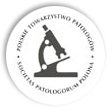Aktualnosci
Warto poczytać .....................
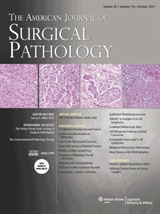 |
American Journal of Surgical Pathology, Vol. 35, No. 8, August 2011 - Page 1093: Encapsulated papillary carcinoma (EPC) of the breast may be interpreted either as an intraductal papillary carcinoma (intracystic papillary carcinoma) or a solid papillary carcinoma (with mucin production, neuroendocrine features, often multinodular) that is circumscribed, encapsulated and lacks myoepithelial cells. This study shows that it is an indolent tumor with a favorable prognosis when adequately excised surgically. Note that papillary DCIS has an intact myoepithelial layer throughout the lesion and diffusely involves a TDU. - Page 1104: “Porcelain gallbladder” comprises a dense paucicellular hyaline fibrosis with a thin uniform wall and calcification. This study proposes the term hyalinizing cholecystitis and shows that about 15% of these gallbladder harbor adenocarcinoma. - Page 1114: Mixed epithelial and stromal tumor (MEST) of the kidney, biphasic, cystic or solid, with diverse stroma (ovarian-like, smooth muscle) is a neoplasm, by virtue of its clonal nature, as shown in this study using the X-chromosome inactivation (Humara gene) assay. - Page 1146: FISH positive increased copy number of chromosomes 6 & 11 provides independent prognostic information on malignant melanoma with an increased risk of metastases or melanoma-related death compared to FISH negative cases. - Page 1151: Collagenous ileitis similar to colon and stomach in morphological criteria. - Page 1165: HGPIN in prostatic biopsies are likely to show cancer in six months (46%) and one year (64%), with the risk being higher with multifocal HGPIN (i.e. more than one core). - Page 1168: Cribriform adenocarcinoma of tongue (CAT) was first published in 1999, with the WHO regarding this as a variant of PLGA. This study with an additional 23 cases pledges this as a separate distinct entity. Note that the nuclei resemble those of papillary carcinoma of the thyroid. - Page 1177: Malignant fat (previously termed “lipomatous HPC”) forming SFT (14 cases) carries the same criteria as the “usual” malignant SFT: hypercellularity, >4/10 mitoses, moderate cytologic atypia, and necrosis. Note that in five cases ALT-like areas were present in the fat, with the authors proposing a search for malignant SFT when the latter is noted. |
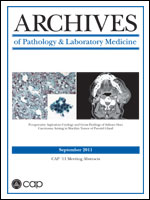 |
Archives of Pathology and Laboratory Medicine, Vol. 135, No. 8, August 2011 - Page 969: Mislabelling of cases, specimens, blocks and slides (in this CAP Q-probes study involving 136 institutions) is equally distributed through accessioning, grossing, processing and tissue cutting. An incidence of 0.1% was documented with the errors typically being detected/corrected in the next immediate step, reinforcing the need for quality checks throughout the system. - Page 975: Metastatic breast carcinoma to the skin is positive for mammoglobin in 66% of cases, whilst p63 is positive in 90% of cutaneous sweat gland carcinomas with only 8% of breast cancers positive with the latter markers. - Page 1001: Epithelial-mesenchymal transition is also the mechanism applicable to synovial sarcomas. Monophasic spindle cell sarcomas (increased snail/slug, decreased E-cad and nucleocytoplasmic β-catenin expression patterns) contrast with the glandular component in biphasic synovial sarcomas (decreased snail and increased E-cad expressions), suggesting that the monophasic SS develops through EMT. - Page 1037: Angiocentric gliomas are superficial cerebral tumors with both ependymal and astrocytic growth patterns. Four of five cases in this study were associated with chronic epilepsy and adjacent cortical dysplasia/malformation (similar to ganglioglioma and DNET), suggesting a developmental basis to the origin of these rare tumors. |
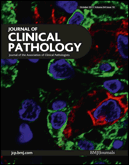 |
Journal of Clinical Pathology, Vol. 64, No. 8, August 2011 - Page 654: Histiocytoid breast carcinoma is a lobular neoplasm with associated apocrine LCIS (GCDFP-15 positive). The bland histology with cytoplasmic vacuolar/secretion requires IHC to confirm the epithelial nature. |
 |
Histopathology, Vol. 59, No. 11, July 2011 - Page 55: Lobular endocervical hyperplasia (associate pyloric gland metaplasia) has been proposed as a putative precursor of adenocarcinoma and minimal deviation adenocarcinoma of the cervix. This study proposes that LEGH-associated adenocarcinoma may carry a better prognosis than previously expected. - Page 106: Mammary carcinoma with neuroendocrine differentiation is an under-recognized entity, defined as having >50% neuroendocrine differentiation on IHC (WHO, 2003). If small cell carcinoma and solid papillary carcinoma (see AJSP, Aug 2001, page 1093) are excluded, then the cytomorphology comprises papillary, nested patterns with round/polygonal, plasmacytoid, spindled, or signet ring cells with a granular, eosinophilic, clear or finely vacuolated cytoplasm. Recognition of this cytomorphology and appropriate IHC to render this diagnosis is proposed. |
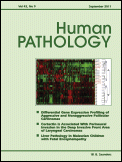 |
Human Pathology, Vol. 42, No. 8, August 2011 - Page 1149: Plasmacytoid urothelial carcinoma of the bladder comprises a discohesive growth pattern of plasmacytoid cells with eccentric nuclei. The tumor often demonstrates transmural invasion with perivesicular fat involvement. The tumor cells resemble plasma cells but are cytokeratin/EMA positive. However, beware since CD138 is strongly positive (LCA, kappa/lambda light chains negative). - Page 1178: Expanding the spectrum of IgG-4 associated inflammatory pseudotumors involving the ureter (3 cases). |
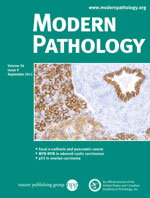 |
Modern Pathology, Vol. 24, No. 8, August 2011 - Page 1060: Epithelial-mesenchymal transition (EMT) in esophageal squamous carcinoma is strongly associated with prognosis. Recall that EMT is essentially characterized by loss of E-cad along with Snail-dependent E-cad repression and nucleocytoplasmic expression of β-catenin. This group proposes four classes of EMT expression patterns (epithelial loss, hybrid, null and wild types). - Page 1111: HER2 gene amplification (by FISH) in a subset of micropapillary variant of urothelial carcinoma of the urinary bladder may see HER2 targeted therapy being successful.
|




